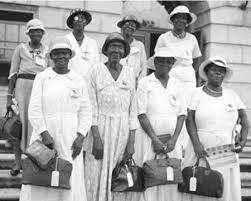Modernizing Motherhood, Looking to the Past
- Alex Vtorov
- Nov 16, 2021
- 4 min read
Written by Alex Vtorov
In honor of PHHR’s first event last week, this week’s post will address maternal health, racial disparity in healthcare outcomes, and the decline of midwifery in the United States. Ms. Eva Martineau, BSN, MPH, who presented in collaboration with Hunter’s own Health Literacy Initiative, is a certified nurse midwife and lactation consultant, with extensive experience in the city’s Department of Health and in community activism. Ms. Eva Martineau is featured on our header photo for this week's post.
Among obstetric caregivers, the balance of influence has fallen heavily in favor of OB/GYNs within the past century. Midwives and doulas, who traditionally delivered the majority of the nation’s children, now frequently find their work sidelined or even criminalized. Certified Nurse Midwives (CNMs) are able to legally practice in all 50 states, but must frequently conform to the supervision of private healthcare systems. Other “informal” natal and post-natal care is subject to a flurry of litigation, much of which varies state by state. Some states allow licensure but not practice, or vice versa, and some outright ban or ignore maternal healthcare outside hospitals.
Why did this happen?
Almost anywhere in the world, particularly developed nations, midwives perform 75% of all deliveries, which is reflected in relatively low rates of Caesarean births and other invasive procedures. The US used to share this same system, promoting minimal trauma to both the mother and infant unless absolutely necessary. The overwhelming majority of midwives were African American women, both before and after the abolition of slavery. The cultural practices they inherited and spread throughout the country significantly lowered neonatal mortality, particularly at a time when formalized medicine or medical certification was virtually non-existent.
In part, due to rising concerns about malpractice in other fields, American society witnessed a push towards more paternalistic and centralized systemization of medicine in the late 19th century. Maternal health, though in fact one of the few areas where more intimate, less formal care frequently produced better outcomes, was nevertheless caught in the crossfire. Midwives had promoted intimate care, with maximum agency being given to each individual mother. With the systemization of care, however, medicine increasingly formalized male dominance. Many medical professionals at the time treated pregnancy as pathologic, promoting general anesthesia and invasive surgery in delivering women. Women traditionally birthed upright, at home, in the familiar care of local midwives and friends or family. By the 1930s to 1960s, many were having Caesarean births lying down in sterile environments, significantly reducing their personal agency in medical decisions. While midwives continued to be integrated into healthcare systems throughout Europe and most other developed nations as their respective medical systems modernized, they were outlawed or criticized throughout America, and especially in the South.
Much of this criticism was racially charged. Modern medicine was contemptuous of the value of cultural knowledge or personal empathy that many black nurses and “granny midwives” offered, not merely within their own communities but throughout society. This led to the prohibition of lay midwives in the 19th century, forcefully formalizing a profession that far predated any modern certification. Standardized medicine pursued that standardization even when it became obvious that black women systematically suffered in medical environments where they remained unrepresented. Shafia M. Monroe, of the Midwives Alliance of North America, states that “one of the darkest moments in US history was the systematic eradication of the African American midwife from her community, resulting in a legacy of birth injustices.” African Americans continue to suffer from disproportionally high maternal and infant mortality rates, or other complications and abuses during delivery.
As a country, the US similarly ranks far behind most other nations, many of whom retained their midwives as valued partners in medical care. The country ranks 17th in the world for maternal mortality rates, far behind even several non-industrialized nations. In NYC specifically, the mortality rate among African American women is particularly egregious, 8 times that of women of other races. Worryingly, mortality rates across the country appear to have been rising since 2000, completely contradicting more positive global trends. The disproportionate prevalence of invasive procedures, resulting in unnecessary death and injury, is holding the nation back from achieving true equity in natal care.
Midwives have always been agents of change, advocating for pregnant mothers. Increasingly, they are involved in campaigns to reinforce legal protections for abortions, push for the destigmatization of birth, and are struggling to combat the enduring paternalization of neonatal care. Rejuvenating an industry that has existed since antiquity could ultimately bring the US into the 21st century.
Further Reading
Data
Background
Adams, A. Frank, et al. “Occupational Licensing of a Credence Good: The Regulation of Midwifery.” Southern Economic Journal, vol. 69, no. 3, Southern Economic Association, 2003, pp. 659–75, https://doi.org/10.2307/1061700.
Alonso, Cristina. “Integrating the Midwifery Model of Care into Abortion Services.” Sexual and Reproductive Health Matters, vol. 28, no. 1, Taylor & Francis, Ltd., 2020, pp. 66–68, https://www.jstor.org/stable/48617610.
Belizán, José M., et al. “Commentary: Health Consequences of the Increasing Caesarean Section Rates.” Epidemiology, vol. 18, no. 4, Lippincott Williams & Wilkins, 2007, pp. 485–86, http://www.jstor.org/stable/20486406.
Bonaparte, Alicia D. “‘The Satisfactory Midwife Bag’: Midwifery Regulation in South Carolina, Past and Present Considerations.” Social Science History, vol. 38, no. 1–2, Cambridge University Press, 2014, pp. 155–82, http://www.jstor.org/stable/90017027.
Craven, Christa. “Claiming Respectable American Motherhood: Homebirth Mothers, Medical Officials, and the State.” Medical Anthropology Quarterly, vol. 19, no. 2, [American Anthropological Association, Wiley], 2005, pp. 194–215, http://www.jstor.org/stable/3655486.
Craven, Christa, and Mara Glatzel. “Downplaying Difference: Historical Accounts of African American Midwives and Contemporary Struggles for Midwifery.” Feminist Studies, vol. 36, no. 2, Feminist Studies, Inc., 2010, pp. 330–58, http://www.jstor.org/stable/27919104.
World Health Organization. “WHO Statement on Caesarean Section Rates: World Health Organization Human Reproduction Programme, 10 April 2015.” Reproductive Health Matters, vol. 23, no. 45, Taylor & Francis, Ltd., 2015, pp. 149–50, https://www.jstor.org/stable/26495853.







Comments